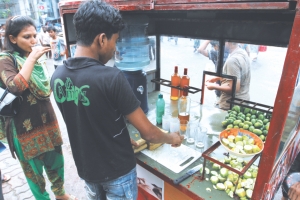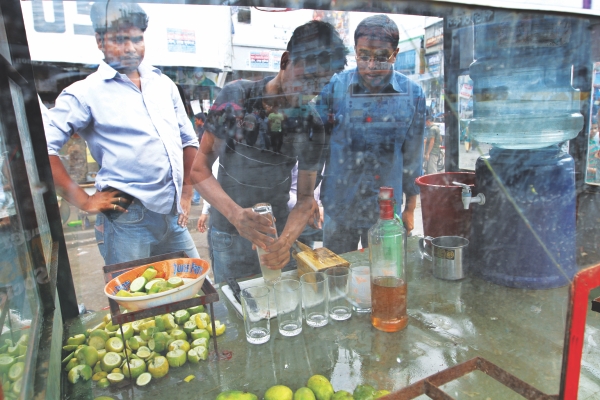| Home - Back Issues - The Team - Contact Us |
 |
| Volume 11 |Issue 25| June 22, 2012 | |
|
|
Health DIRTY DRINKING Anika Hossain Most people living in this city tend to think they have cast iron stomachs, that can digest anything, from the fancy food at fancy restaurants with not so fancy kitchens (often rat infested) to the delicious looking, yet contaminated food widely available around every street corner. This confidence often borders on idiocy, as we blame all our health issues on the sickening food and drinks we consume and still continue to devour them like mindless gluttons.
In the summer months, those who claim to be hygiene conscious (including myself) will drink anything from coconut water, sugarcane juice, green mango juice, star fruit juice, pineapple juice and tea from the roadside stalls and office canteens and console themselves by saying they've wiped the glass/straws/cups etc so it can't be “all that bad.” To give them a quick reality check, let's take a look at what makes these drinks oh so yummy. Mallick Mia owns a sugarcane juice trolley which he sets up near Saat Masjid road in Dhanmondi. He peels and cuts the sugarcane with a large sharp knife, which was once upon a time silver in colour but over the years has had a drastic makeover and is now black (not smooth, a little lumpy). This knife, he sharpens on a stone which rests on the footpath next to the stall and is often kicked around by Mallick's little boy and his playmates who are mostly beggars. The sugarcane is then put in a once white plastic (but now greying) contraption which squeezes the juice out. It is then poured into little glass cups. When the customers are done with the cups, they are dumped into a single grimy balti (bucket), cracked on one side and filled with what looks like dirty water from the Dhanmondi lake (but probably is just tap water) and placed on one end of the trolley to dry and be reused (after Mallick scratches his behind and blows his nose before touching them). “I change the water every day, two days at the most,” claims Mallick proudly, as he washes his knife in it. Astonishingly enough, even though all this is done in plain sight, Mallick still gets around 40 customers daily. Disgusting much? Shohag Mia, a coconut seller doing fantastic business on Green road claims that he reuses some of his straws. “I wash them before I give them to people,” he defends himself and points to an equally filthy bucket (red one with black slime) as Mallick's, next to his push-cart.
“There is definitely food value in fresh fruit juice,” says Dr Nasrin Parveen, “In sugarcane juice, the concentrated sugar gives you a boost in energy which is much needed in this hot weather. Unfortunately, consuming these fruit juices involves many risks, simply because of the way they are prepared. When the fruit juice comes into contact with dirty water and utensils, people are exposed to water borne diseases such as typhoid, dysentery, diarrhea, cholera etc, some of which can be life threatening.” Not just that, say the vendor has warts, worms and other skin infections and he scratches himself in various regions of his body (especially his backside), the customer is exposed to these and can contract the same condition. “The bacteria, dust and pollution in the air, which the juice is exposed to can also lead to many different types of illnesses,” says Dr Parveen. “Often, old off season, decomposing fruits are used to make these juices and we foolishly think we're getting a treat, but once these germ infested liquids enter the intestines, they cause immediate and serious internal problems which can lead to hospitalistion,” she explains. For your information, let us glance at what these much heard of diseases actually entail. Diarrhea, the least scary of them all but perhaps the most annoying and embarrassing, describes loose, watery bowel movements. Usually, many people have this once or twice a year, but if you live in Dhaka you are more intimately acquainted with this particular disease. Diarrhea's cousin dysentery, is an inflammatory disorder that affects the intestine, the colon more specifically which results in severe diarrhea mixed with mucus and/or blood. This is accompanied by fever, abdominal pain and rectal tenesmus. Oh and if you don't get treatment you can die. Cholera affects the small intestines. It causes a release of water in the intestines which also produces severe diarrhea. Poor sanitation and crowding is the main cause of this disease. Last but not least, typhoid fever is a bacterial infection of the intestinal tract and occasionally the bloodstream, caused by poor sanitation and consumption of water contaminated by feces of infected humans and can prove to be fatal. On that pleasant note, we can safely come to the conclusion that fruit juices and other drinks sold on the streets are not very healthy. It's hot and unpleasant and yes, an occasional drink can be refreshing and even if you might think so at times, what you need to think about is whether it is truly worth dying for. Use that common sense you were born with. That's all.
Copyright
(R) thedailystar.net 2012 |

